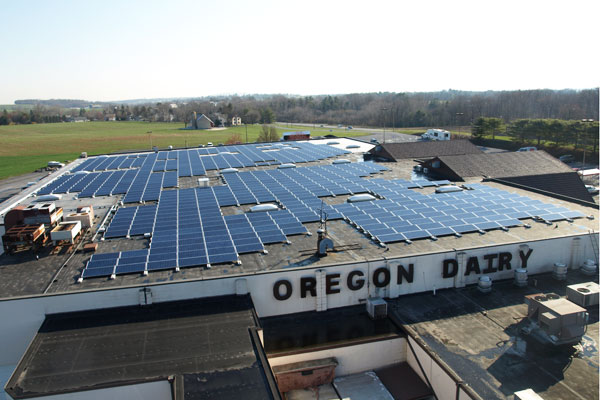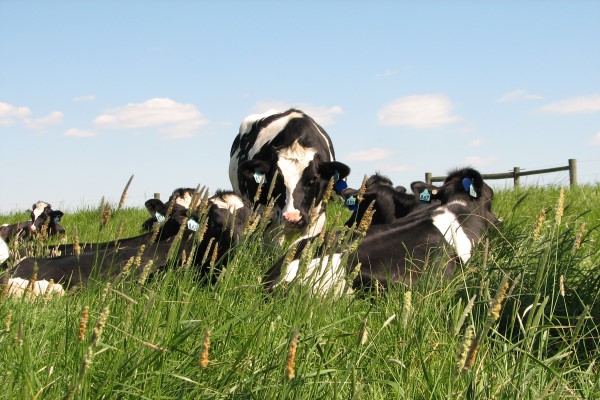


Oregon Dairy Solar Farm
How do orphans in Africa, a local grocery store and the power of the sun relate?
The answer is with Oregon Dairy’s new PV solar system which was officially turned on and generating power as of March 31, 2011.
“How do the orphans play into this story?” you might ask.
Horizon Energy, LLC, a non-profit organization in Lancaster PA, was the lead developer on the solar project. Horizon Energy is an energy services and solar development company, formed by a group of venture capitalists with a big heart for orphans. Their profits go directly towards developing micro communities in Africa; the communities generally consist of an orphanage, school, farm, medical clinic and in some cases micro businesses. Horizon Energy partners with local individuals to aid the community in becoming economically self sufficient. Board Chairman & CEO Daryl Heller comments, “We are Venture Capitalists generating wealth to empower the poor.”
Horizon Energy, LLC hired Ephrata based company MVE Solar to design and install the solar system at Oregon Dairy.
Oregon Dairy is a family friendly supermarket, restaurant, gift shoppe and bakery – all on a real working Lancaster County PA farm. They are committed to exploring and utilizing all forms of renewable energy which make sense to them, the community and the world.
Co-owner of Oregon Dairy, Vic Hurst, understands that solar makes sense. Hurst states, “It simply makes sense to utilize the empty space of available roof tops to generate electricity right at the point of consumption. By doing so we reduce the need for additional generation and transmission infrastructure, lessen our overall dependence on more costly methods of electrical production, and take advantage of readily available and proven technologies. Solar is quite possibly the most viable existing option when it comes to meeting those criteria. Because of our long term relationship with MVE and their repeated demonstration of performing to our expectations, they were our preferred install contractor.”
Oregon Dairy is the first solar system of its size in Manheim Township and now as of 2020, it is the 4th largest in Manheim Township. There are currently 162 solar arrays installed in Manheim Township all under the size of 15 KW, and a few larger projects are in the works. Oregon Dairy’s solar system totals 220.85 KW. This means it will produce approximately 264,516 kWh annually, which is about the equivalent of powering 30 average sized homes per year.
Manheim Township Commissioners were extremely pleased with the project. Andrew Bowman, Construction Code Official for Manheim Township stated, “Working through the building permit and inspection process with MVE Solar is proof that a fully compliant PV system can be installed successfully with minimal municipal interference. The proactive attitude of both the MVE Solar office and field staff made issuing the building permit and inspecting the PV system easy. This was a professional installation by a group of dedicated PV professionals.”
You can view before and after photos of the solar project on MVE Solar’s website: www.mvesolar.com.

The Power of Poop!
1. The power of poop!
a. Oregon Dairy has been producing their own electricity from cow manure for over 30 years. The process works by having the manure flow into large underground tanks and a large upright storage tank where it is heated to about 100°. For 20 days, the manure is in the methane digester. This process produces methane gas, which in turn is used to run an engine. A generator attached to the engine produces electricity (120 kilowatts per hour) that is used on the farm. The excess electricity is used by the homes on The Farmstead at Oregon Dairy, The Market at Oregon Dairy and The Restaurant at Oregon Dairy. The heat from the engine is also used to heat the farm house and the hot water for the barn. After the digester process is completed, the manure is separated into solids and liquids. The solids are used for bedding for the cows and the liquid is used as a fertilizer for the fields.
b. The farm produces 900,000 kilowatts per year or between $65 – $75 thousand dollars worth of electricity. That would supply electricity to 660 homes @ $100 per month.
2. Oregon Dairy Organics is our composting facility that is located on The Farmstead at Oregon Dairy. They use manure from our heifer barns and food waste from The Market & The Restaurant at Oregon Dairy, other local supermarkets and restaurants, local colleges, etc. and mix it together and compost it. The compost is sold wholesale to gardeners, homeowners, landscapers, athletic fields and golf courses. It is also available for purchase in our Lawn & Garden center at The Market at Oregon Dairy.
a. Oregon Dairy Organics sells 26,000 cubic yards of finished compost a year.
b. From start to finish, it takes 3 months to transform raw product (cow manure, horse manure, food waste) to ready to use compost.
3. Renewable Energy
a. Oregon Dairy installed solar panels on the roof on April 4, 2011. Since we installed the panels, we have generated 3,180.000 kilowatts of electricity. Annually, the solar panels produce approximately 264,516 kilowatts of electricity which is about the equivalent of powering 30 average sized homes per year.
4. Recycling Waste Oil
a. In 2015, The Restaurant at Oregon Dairy recycled an average of 740 gallons of vegetable oil which equals about 5,600 lbs of oil. Since we started recycling vegetable oil, we have diverted over 30 tons of vegetable oil from going into the landfill.
5. Recycling Cardboard & Plastic Bags
a. In 2022, The Market at Oregon Dairy Recycled 496 Cardboard Bales! Each Bale Weighs Approximately 900 pounds! Totaling 446,400 pounds or 223.2 Tons of Cardboard!
b. In 2022, The Market at Oregon Dairy Recycled 936 Plastic Bundles at 10 pounds a bundle. Totaling 9,360 pounds or 4.68 Tons of Plastic!
6. Buy Local – Fresh from Our Farm to Your Fridge!
a. The Market at Oregon Dairy has been selling its own milk from the farm since 1975. The milk is drawn from the cows, flowing directly into a tank through the milk line with no hands ever touching the milk. The temperature of the milk is 101° once it leaves the cows and within 3 – 5 minutes, is cooled to 38°.
b. It used to take 1 person, 1 hour to milk 6 cows. Today, one person and machines can milk 100 cows in 1 hour.
c. Our 60 cows produce about 500 gallons of milk a day, or about 8,000 cups.
d. On average, a cow gives around 9 gallons or 130 glasses of milk a day.



